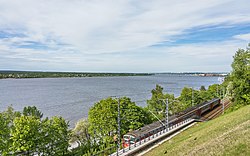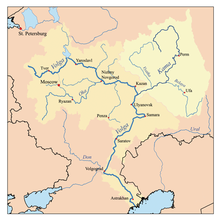| This article needs additional citations for verification. Please help improve this article by adding citations to reliable sources. Unsourced material may be challenged and removed. Find sources: "Kama" river – news · newspapers · books · scholar · JSTOR (January 2014) (Learn how and when to remove this message) |
| Kama | |
|---|---|
 The Kama River in the city of Perm The Kama River in the city of Perm | |
 Map of the Volga's watershed with the Kama's watershed highlighted Map of the Volga's watershed with the Kama's watershed highlighted | |
| Native name | Кама (Russian) |
| Location | |
| Country | Russia |
| Physical characteristics | |
| Source | Kama (river) |
| • location | Kuliga, Udmurtia |
| • coordinates | 58°11′20″N 53°45′00″E / 58.189°N 53.750°E / 58.189; 53.750 |
| • elevation | 360 m (1,180 ft) |
| Mouth | Volga River |
| • location | Kamsko-Ustyinsky District, Tatarstan |
| • coordinates | 55°21′50″N 49°59′52″E / 55.36389°N 49.99778°E / 55.36389; 49.99778 |
| • elevation | 45 m (148 ft) |
| Length | 1,805 km (1,122 mi) |
| Basin size | 507,000 km (196,000 sq mi) |
| Discharge | |
| • average | 4,100 m/s (140,000 cu ft/s) 4,320 m/s (153,000 cu ft/s) |
| Basin features | |
| Progression | Volga→ Caspian Sea |
The Kama (UK: /ˈkæmə/ KA-mə, US: /ˈkɑːmə/ KAH-mə; Russian: Кама [ˈkamə]; Udmurt: Кам), also known as the Chulman (/tʃuːlˈmɑːn/ chool-MAHN; Tatar: Чулман / Çulman [tɕuɫˈmɑn]), is a 1,805-kilometre (1,122 mi) long river in Russia. It has a drainage basin of 507,000 square kilometres (196,000 sq mi). It is the longest left tributary of the Volga and the largest one in discharge. At their confluence, in fact, the Kama is even larger in terms of discharge than the Volga.
It starts in the Udmurt Republic, near Kuliga, flowing northwest for 200 kilometres (120 mi), turning northeast near Loyno for another 200 kilometres (120 mi), then turning south and west in Perm Krai, flowing again through the Udmurt Republic and then through the Republic of Tatarstan, where it meets the Volga south of Kazan.
Before the advent of railroads, important portages connected the Kama with the basins of the Northern Dvina and the Pechora. In the early 19th-century the Northern Ekaterininsky Canal connected the upper Kama with the Vychegda River (a tributary of the Northern Dvina), but was mostly abandoned after just a few years due to low use.
The Kama featured in the 2013 Russian film The Geographer Drank His Globe Away, in the climactic rapids scene.
Dams and reservoirs
The Kama is dammed at several locations:
- At Perm, by the dam of the Kama Hydroelectric Station, forming the Kama Reservoir;
- At Chaykovsky, by the dam of the Votkinsk Hydroelectric Station, forming the Votkinsk Reservoir;
- At Naberezhnye Chelny, by the dam of the Nizhnekamsk Hydroelectric Station, forming the Nizhnekamsk Reservoir.
Tributaries
The largest tributaries of the Kama are, from source to mouth:
- Veslyana (left)
- Kosa (right)
- South Keltma (left)
- Vishera (left)
- Yayva (left)
- Inva (right)
- Kosva (left)
- Obva (right)
- Chusovaya (left)
- Tulva (left)
- Siva (right)
- Buy (left)
- Belaya (left)
- Izh (right)
- Ik (left)
- Toyma (right)
- Zay (left)
- Vyatka (right)
- Sheshma (left)
- Myosha (right)
Gallery
-
 Crossing of the rivers Chusovaya (tributary) and Kama
Crossing of the rivers Chusovaya (tributary) and Kama
-
 View in Yelabuga
View in Yelabuga
-
 A Russian truss bridge by Lavr Proskuryakov. Early colour photograph, taken ca. 1912.
A Russian truss bridge by Lavr Proskuryakov. Early colour photograph, taken ca. 1912.
Volga or Kama
| This section is written like a personal reflection, personal essay, or argumentative essay that states a Misplaced Pages editor's personal feelings or presents an original argument about a topic. Please help improve it by rewriting it in an encyclopedic style. (March 2024) (Learn how and when to remove this message) |
Even today, disputes over the primacy of the rivers continue: Volga or Kama? Scientific facts say that the Volga flows into the Kama, and not vice versa. The confluence of the Volga and the Kama has exactly the same water content (Volga: 3,500 m/s; Kama: 4,100 m/s). The source of the Volga (228 m) is below the source of the Kama (331 m), which is the main factor in determining the superiority of any river. Compared to the Kama basin (507,000 km), the Volga has a larger basin (604,000 km). More rivers flow into the Kama than the Volga. Experts have proven that the valley of the Kama River is more ancient than the Volga River valley. In other words, at the time of the existence of the ancient Kama, also known as the Paleo-Kama, there was no Volga. Later, geological changes caused the Volga to join the Kama at right angles. Also looking at the map, we can understand that the confluence of the Kama and the Volga is the continuation of the Kama canal. The bed of the Kama is lower, so the Volga clearly flows into the Kama.
References
- "Definition of Kama River in English". Oxford Dictionaries. Oxford University Press. Archived from the original on March 8, 2016. Retrieved January 11, 2014.
- ^ «Река КАМА», Russian State Water Registry
- "The Kama River is the main tributary of the Volga. Description, characteristics, map, photo, video of the Kama river-The origin of the word Kama". 2019.
External links
 Media related to Kama River at Wikimedia Commons
Media related to Kama River at Wikimedia Commons- Naberezhnye Chelny and the Kama River
| The river Kama | ||
|---|---|---|
| Left tributary of the Volga | ||
| Tributaries |  | |
| Reservoirs | ||
| Hydroelectric stations | ||
| Volga River | ||
|---|---|---|
| Tributaries |
|  |
| Reservoirs | ||
| Hydroelectric stations | ||
| Canals | ||
| Cities | ||